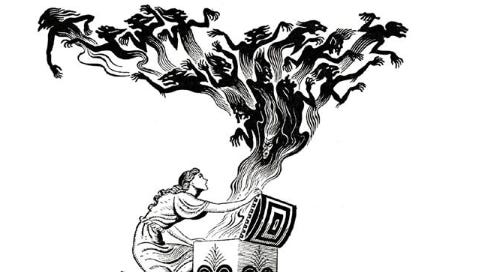This new post expands my earlier road map.
The road map made eight claims.
Let’s unpack four of them.
FIRST CLAIM.
Human universals, not our real or imagined differences, control the rise and fall of civilizations. This is cause for cautious optimism.
Let’s unpack.
Why universals?
we can (it works)
we should (morals, ethics, or pragmatic self-interest, you pick)
we must (rising technology forces our hand)
we can (and here’s how)
Why caution?
everyone is part of the problem
tensions are high
wrong moves can be disastrous
Why optimism?
everyone can also be part of the solution
the mission is clear
the methodology is user-friendly
SECOND CLAIM.
Civilization hangs by a thread. Mistrust is exploding, institutions are collapsing, and tempers are on fire.
Is there a way out, other than catastrophe?
Yes. The LoRC methodology shows us that path.
Again, let’s unpack.
Problem: Humanity has opened a high-technology variant of Pandora’s Box.
Technology enriches your daily life, but it also exposes you to other people’s bad decisions.
Accelerating trends create worsening mismatches.
Suddenly, your networked opponents are too numerous to destroy, too agile to avoid, and too upset to ignore. Your way of life is under constant attack.
And everyone else feels the same way...
Urgency: Time is short.
Without Hope, catastrophe seems certain. How much time is left? We don’t know. A quest seems in order. But how can we work together when everyone is at each other’s throats?
Methodology: A Heroic Quest appears!
Meet the Law of Radical Consensus (LoRC), a social problem-solving method for the Internet Age.
What: “Any disagreement,” it says, “can be reframed as a form of consensus, by jointly acknowledging THAT the dispute exists.”
EXAMPLE: Everyone agrees that people get emotionally invested in dumb ideas. We just don’t agree on which (or whose) ideas are dumb.
How: To solve problems, apply the LoRC in layers until consensus and universality converge in a handful of self-evident observations. This establishes a common view of the problem. Then, AND ONLY THEN, reason forward together until something interesting happens.
Why: Rational argument fails without shared premises. Runaway “too-much-information-too-fast” technology obliterates them. The LoRC restores them. Simply, virally, effectively.
Discussion:
The LoRC is a major methodological contribution. Custom-engineered as a bookend to Classical Rationality, it upgrades the persuasive power of argument, restoring it to full functionality even in the chaos of the [dis]Information Age.
A full write-up is in the works. For now, here’s a list of benefits.
The Law of Radical Consensus:
is easy to learn, and fun to use
cuts through disinformation
de-escalates social tension
unmasks bots and trolls
exposes manipulation
converts opponents
attracts new allies
improves trust
gets results
The Law of Radical Consensus is a powerful tool. But it does not, by itself, bring us Hope.
Agreeing that “people everywhere are unpredictably horrible” is an admission of Despair, not a lasting solution to society’s urgent problems.
We need something better.
To find Hope, we must master the LoRC methodology, point it at the enigma of human decision-making, and follow along as it leads us through an extraordinary Hero’s Journey of self-discovery.
THIRD CLAIM.
Reasoning and Deciding are separate human mechanisms.
Meme humor meets LoRC-inspired content! The LoRC methodology demonstrates just how easily it can
disarm your defenses
arouse your curiosity
separate toolkit from target
launch a powerful line of attack
Did it work? Sit back and watch what happens.
FOURTH CLAIM.
But one can be used to map the other.
First, let’s unpack the instructions for drawing the map:
Goal: Create a LoRC-inspired model of human decision-making.
Step 1: Establish a common view of the problem. Apply the LoRC to human decision-making. Keep adding layers until consensus and universality have converged in a handful of self-evident observations (see Parts List, Bottleneck).
Step 2: Reason forward from that common ground. Set the Parts List in motion and watch it self-organize. Reverse-engineer each new layer (see Sub-Assemblies) of decision-making structure (see Final Assembly) as it appears (see Outputs). Collect, assemble, and map the results.
Constraints: Consensus and universality must be maintained at every step. Reasoning must be supported by self-evident observation.
Suggestions: Stick to simple language. Use the broadest available definitions. Handle disputes as they arise. Don’t insist. Just LoRC-loop back to the nearest point of consensus, and then resume reasoning toward the stated objective. For bonus explanatory power, exclude ALL arguments that fail the triple test of consensus, universality, and self-evidence.
Summary of findings: A consensus map, stated in plain language, of self-evident ways in which human decision-making does NOT vary from person to person. That is, a robust map of humanity’s problem-solving (and problem-creating!) machinery.
Next, let’s unpack the map itself.
On second thought, the map needs its own post.
Let’s wait.
If you CAN’T wait, here’s a tease, followed by another tease:
“Instinct inspires self-preservation, but the human sense of self isn’t fixed.”
Unleashing the full implications of the above seemingly innocuous statement
is
what
brings
us
Hope.





